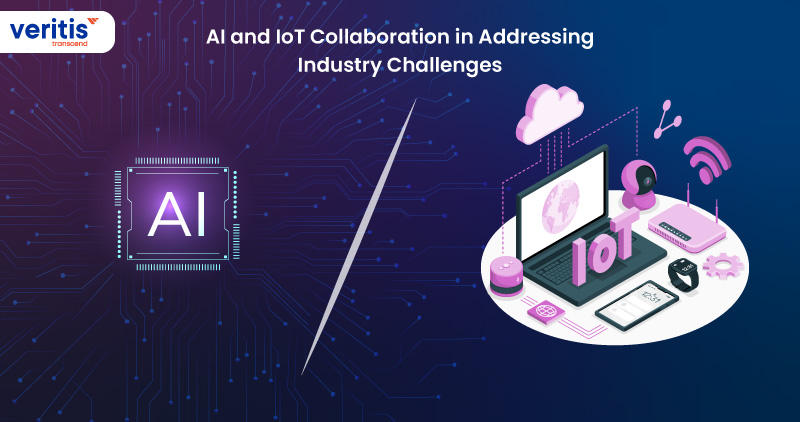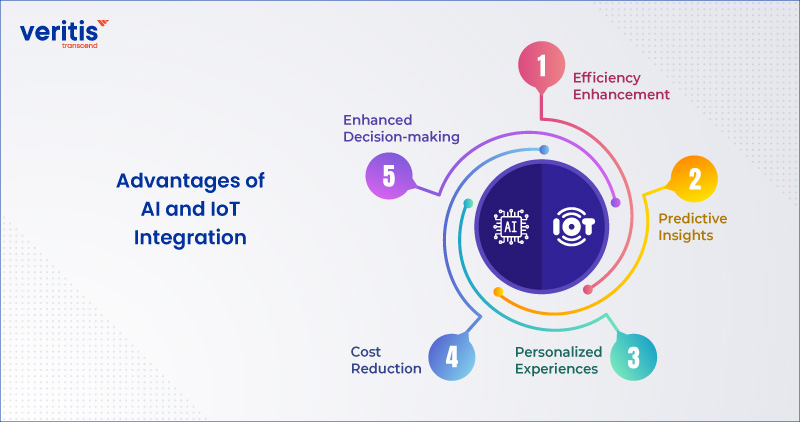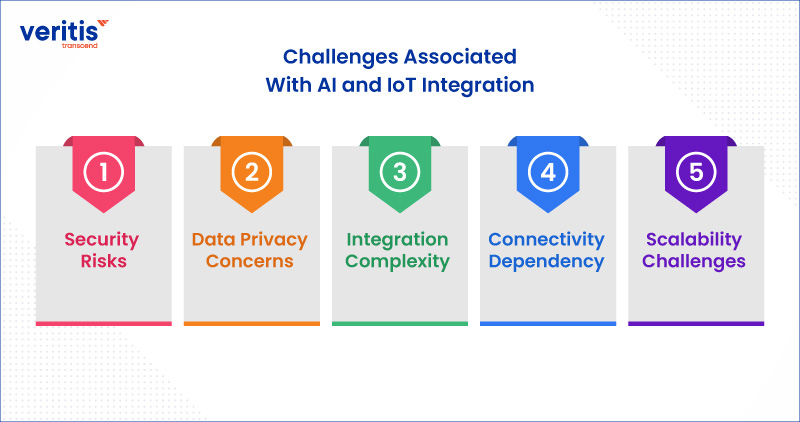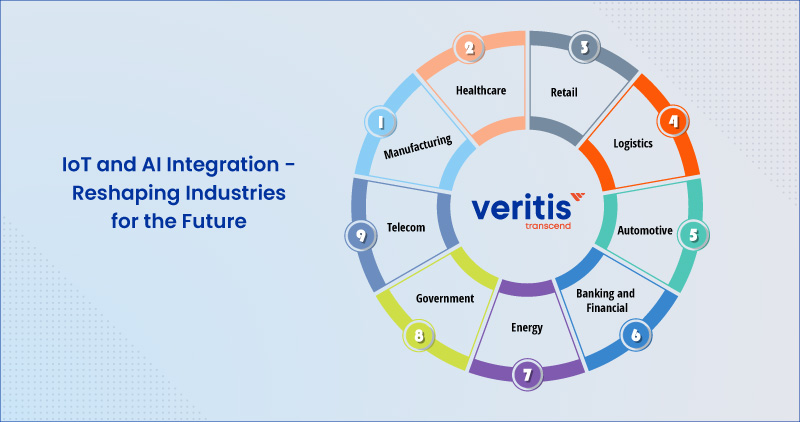
In 1982, Ridley Scott’s visionary film Blade Runner captivated audiences worldwide before autonomous drones and machine learning entered the scene. He presented “replicants,” bioengineered beings virtually indistinguishable from humans, raising questions about artificial intelligence and its societal implications. Since then, there has been much discussion on the movie franchise. Scientists have said that it is just a science fiction film, but the seeds of technological innovation were planted. Whether artificial intelligence takes over the world is debatable, but it has given corporations a revolutionary tool and given us readers/debaters something to think about.
Beyond smart home security and wearables, IoT and AI integration are becoming essential for businesses. Numerous companies, like Microsoft, Amazon, and Oracle, have incorporated artificial intelligence (AI) into their Internet of Things apps to enhance their operations. Numerous industry sectors, such as cloud computing, robotics, healthcare, and online commerce, heavily rely on these cutting-edge technologies. They, therefore, make up a crucial part of the rapidly expanding digital ecosystem.
AI and IoT are redefining the ways organizations operate. On the one hand, artificial intelligence (AI), with its potent subset of machine learning, has made it possible for tasks to be executed more intelligently with real-time analysis and more human-machine interaction. On the other hand, IoT has increased connectivity between humans and devices using innovative technology that works well. Artificial Intelligence and the Internet of Things integrate to create a broader range of powerful applications for each other.
This blog will focus on IoT and AI in the workplace and how these two technologies will affect companies in the future. We’ll examine the many benefits of AI and IoT in the workplace and several use cases that illustrate how these technologies are ingrained in our daily lives.
Combining IoT and AI Systems
These days, systems rapidly integrate AI and IoT to improve device operation and efficiency. This cooperation is the foundation of the AIoT (Artificial Intelligence of Things) idea, which combines AI and IoT to create more intelligent and self-sufficient systems.
Because IoT devices include sensors that gather data in real-time from their surroundings, the AI component has the precise incoming data it needs to apply its sophisticated algorithms to extract insightful information and make wise judgments.
For instance, IoT sensors may monitor a smart home’s security, energy use, and temperature. AI examines this data to improve security procedures, forecast energy requirements, and optimize heating and cooling systems. Through the gradual learning and adaptation process that comes with the integration of AI with IoT, devices can function with greater intelligence, leading to enhanced performance, efficiency, and customized user experiences.
Useful Link: Top 6 IoT Trends to Drive Innovation for Business in 2024
Advantages of AI and IoT Integration

The advantages of AI encompass advanced problem-solving capabilities, increased productivity, and innovative automation. Meanwhile, the advantages of IoT offer real-time data monitoring, seamless automation, and streamlined resource management, enhancing operational efficiency across diverse sectors.
1) Efficiency Enhancement
By amalgamating real-time sensor data with intelligent data analysis, AI and IoT data visualization collaboratively improve operational efficiency and optimize resource allocation, leading to streamlined processes.
2) Predictive Insights
Fusing AI algorithms with historical data from IoT sensors enables predictive analytics, empowering businesses to make proactive decisions and implement preventive maintenance measures based on future trends.
3) Personalized Experiences
The synergy between AI and IoT facilitates personalized user experiences by tailoring responses and actions according to individual preferences and usage patterns, thereby enhancing customer satisfaction.
4) Cost Reduction
Through predictive maintenance and efficient resource management, AI and IoT integration enables cost savings by minimizing downtime, reducing energy consumption, and optimizing workflows.
5) Enhanced Decision-making
Combining AI and IoT gives organizations actionable insights from real-time data analysis, enabling informed decision-making and strategic planning.
Useful Link: Impact of Information Technology on the Financial Industry
Challenges Associated With AI and IoT Integration

1) Security Risks
The interconnected nature of IoT devices amplifies the vulnerability to cyber threats, and the integration with AI applications in business may introduce additional security concerns, necessitating robust security measures to safeguard systems.
2) Data Privacy Concerns
The extensive data collected by IoT devices and processed by AI raises privacy issues, demanding meticulous handling and compliance with regulations to protect user information.
3) Integration Complexity
Integrating AI with IoT devices can be intricate, requiring specialized expertise and compatibility considerations, which may pose challenges during implementation and escalate development costs.
4) Connectivity Dependency
AI and IoT systems heavily rely on network connectivity, and disruptions or latency issues can impede real-time decision-making and functionality, presenting drawbacks in specific scenarios.
5) Scalability Challenges
As the volume of data produced by IoT devices increases, scalability becomes challenging for AI algorithms, necessitating efficient data processing and management solutions to maintain performance.
Useful Link: Securing the Future: AI Automation Tools in Cybersecurity
What are the Upcoming Trends in AI and IoT Development?
Upcoming AI and IoT development trends continuously adapt to tackle challenges and seize new opportunities. Some of the prominent trends include:
1) Edge Computing
Edge computing is gaining traction as a solution to process data closer to the source (i.e., IoT devices) rather than relying solely on centralized cloud servers. This trend aims to reduce latency, enhance real-time processing capabilities, and improve efficiency in AI solutions for business and IoT data analytics systems.
2) AIoT (Artificial Intelligence of Things)
AIoT refers to integrating AI technologies with IoT devices and networks to enhance their capabilities. This trend involves leveraging AI applications in business algorithms to analyze data generated by IoT devices, enabling intelligent decision-making, predictive analytics, and automation.
3) 5G Adoption
The rollout of 5G networks is set to revolutionize the IoT landscape by offering higher bandwidth, lower latency, and more excellent connectivity. This trend will enable the proliferation of IoT devices and applications, facilitating faster data transmission and enabling more advanced AI-driven functionalities.
4) Autonomous Systems
The convergence of AI and IoT drives the development of autonomous systems capable of making intelligent decisions and performing tasks without human intervention. This trend encompasses various applications, including autonomous vehicles, smart factories, and robotic systems.
5) AI-powered Cybersecurity
Cybersecurity threats are becoming more sophisticated due to IoT ecosystems’ increasing complexity and interconnectedness. AI-powered cybersecurity solutions are emerging to detect and mitigate threats in real-time, offering proactive defense mechanisms against cyber-attacks targeting IoT devices and networks.
6) Blockchain Integration
Blockchain technology is integrated with AI and IoT data analytics systems to enhance security, transparency, and trust in data transactions. This trend enables secure data sharing and decentralized management of IoT devices, ensuring data integrity and privacy protection.
These trends highlight AI solutions for business evolution and convergence for AI and IoT technologies, shaping the future of interconnected, intelligent systems across various industries and domains.
Useful Link: What is Generative AI: An Ultimate Guide to Amazon Generative AI Tools
IoT and AI Integration – Reshaping Industries for the Future

Industrial IoT applications have transformed organizational operations by enabling automation, cost reduction, and enhanced customer experiences. As AI advances, its integration with IoT is poised to reshape the business landscape across various industries further. Let’s explore some of the use cases across sectors.
1) Manufacturing
In manufacturing, IoT tracks production and monitors machinery, boosting productivity. AI analyzes data for predictive maintenance and process optimization. Digital twins simulate equipment performance in real-time for enhanced efficiency. Integrating IoT and AI minimizes downtime and streamlines operations for improved efficiency.
2) Healthcare
The convergence of IoT and AI promises transformative impacts in healthcare. IoT devices remotely monitor patients, providing real-time health data. AI algorithms analyze this information, aiding healthcare professionals in informed decision-making. AI-powered personal assistants offer medical advice and streamline patient consultations, reducing costs and enhancing healthcare delivery.
3) Retail
In retail, IoT devices monitor inventory and consumer behavior for market insights. AI systems use this data for personalized shopping experiences, offering tailored recommendations. Smart shopping carts with image recognition and sensors provide real-time updates on promotions, enhancing the shopping experience by guiding customers through the store aisles.
4) Logistics
IoT devices track cargo, monitor vehicles, and optimize routes in transportation. AI algorithms predict traffic patterns, reduce fuel consumption, and cut costs. Integrating self-driving vehicles with logistics ensures safer fleets, enhancing transportation efficiency and sustainability.
5) Automotive
In automotive, IoT and AI revolutionize vehicle connectivity and functionality. Connected cars gather real-time data on performance, driver behavior, and road conditions. AI analyzes this for predictive maintenance and personalized services. Virtual assistants offer voice-activated controls, navigation, and entertainment options, enhancing the driving experience.
6) Banking and Financial
In banking and finance, IoT and AI enhance efficiency and customer experiences. Industrial IoT applications monitor transactions, security, and interactions in real-time. AI-driven chatbots offer personalized services and streamline support processes. Additionally, AI analyzes transaction data to detect fraud and optimize investments, safeguarding institutions and customers.
7) Energy
IoT and AI optimize production, distribution, and consumption for sustainability in the energy sector. IoT sensors collect real-time data on energy production, grid stability, and environmental conditions. AI solutions for business algorithms predict demand, optimize schedules, and balance supply and demand in real time. Smart meters and energy management systems empower consumers to monitor and reduce usage, contributing to a sustainable ecosystem.
8) Government
Governments globally adopt IoT and AI to enhance public service and citizen welfare. IoT sensors gather data on urban infrastructure, transport, and public safety. AI analytics optimize traffic, reduce congestion, and enhance emergency response. Predictive models anticipate and mitigate risks like disasters and health crises. Data-driven policy-making fosters governance transparency and citizen engagement.
9) Telecom
Telecom firms utilize IoT to monitor network performance and deliver personalized services. IoT sensors in infrastructure provide real-time insights into congestion and equipment failures. AI algorithms predict outages, optimize bandwidth, and enhance reliability. Additionally, IoT-enabled devices offer personalized plans and promotions, driving customer satisfaction and loyalty.
Conclusion
Veritis, the Stevie and Globee Business Awards winner, recognizes the transformative potential of integrating IoT and AI across diverse industries. The synergy between these technologies promises to reshape corporate fields, enabling businesses to make informed decisions and enhance efficiency. By leveraging real-time data and insights, organizations can advance customer experiences and stay ahead in the competitive market. Embracing AI- and IoT-enabled business models is pivotal for future success, and Veritis is at the forefront of driving innovation in this space.
Looking for Support? Schedule A Call
Also Read:
- The Rise of Artificial Intelligence and Machine Learning in Financial Decision Making Processes
- Impact of Information Technology on the Financial Industry
- The Future of IT Financial Management: Trends and Innovations
- 5 Key Benefits of Implementing Cloud Financial Services for Your Business
- AIOps Use Cases: How Artificial Intelligence is Reshaping IT Management
- Overcoming Challenges: Implementing Generative AI in Healthcare